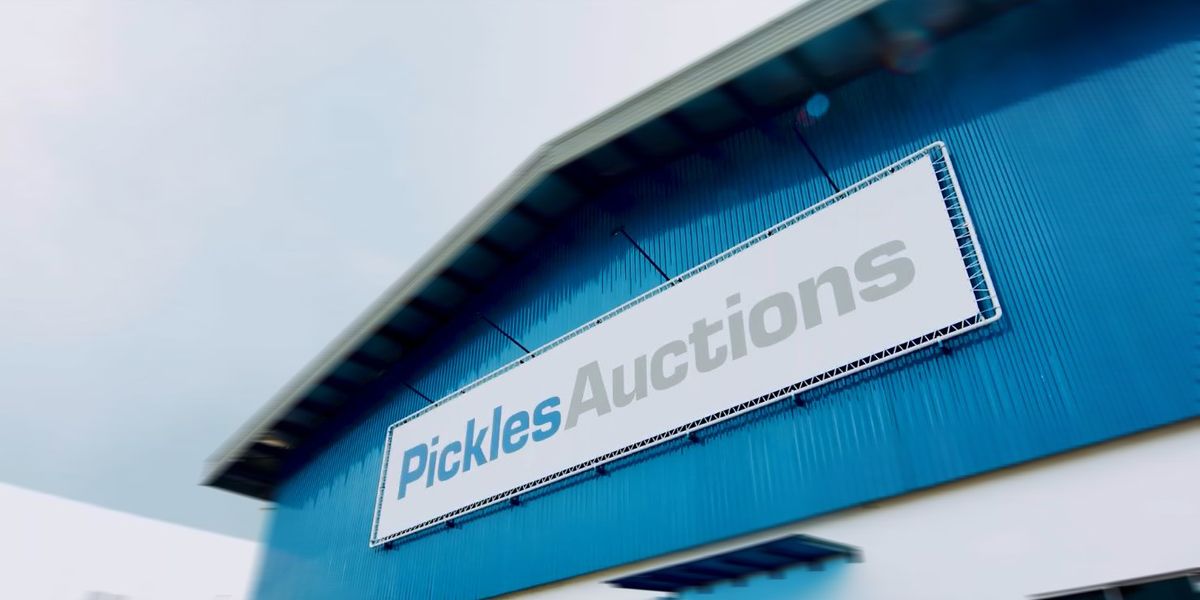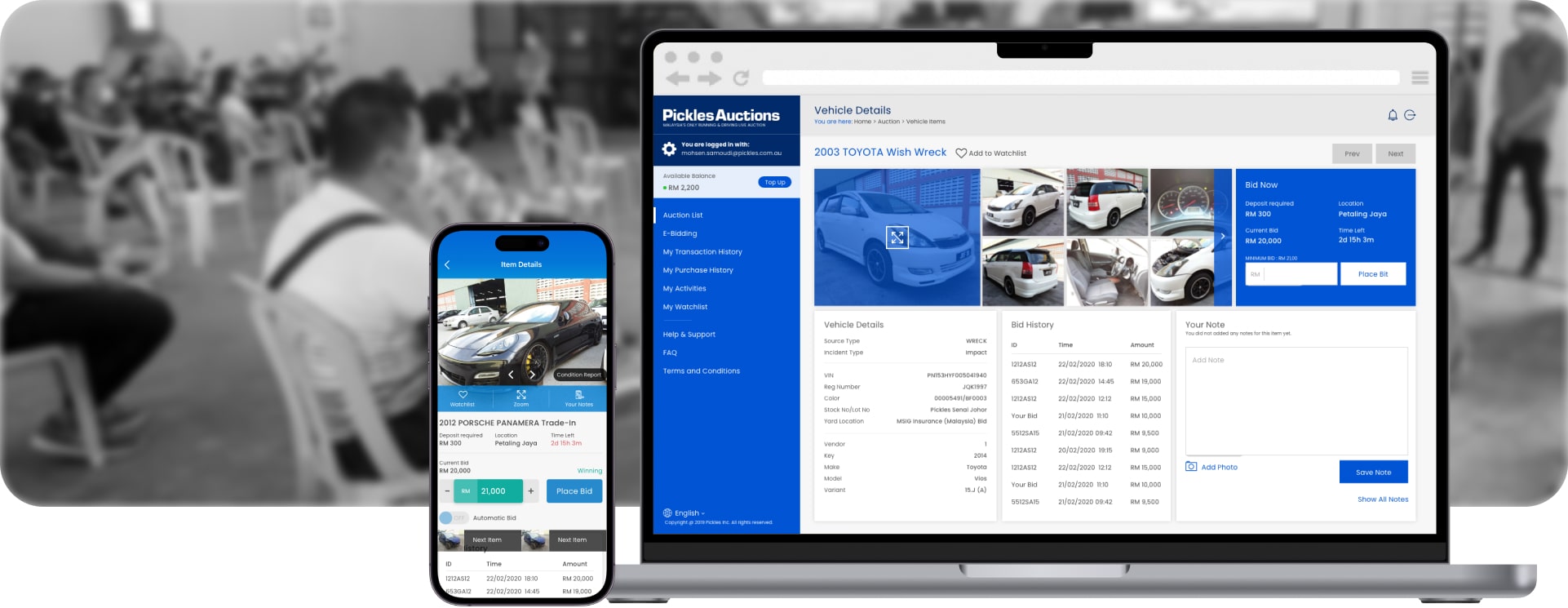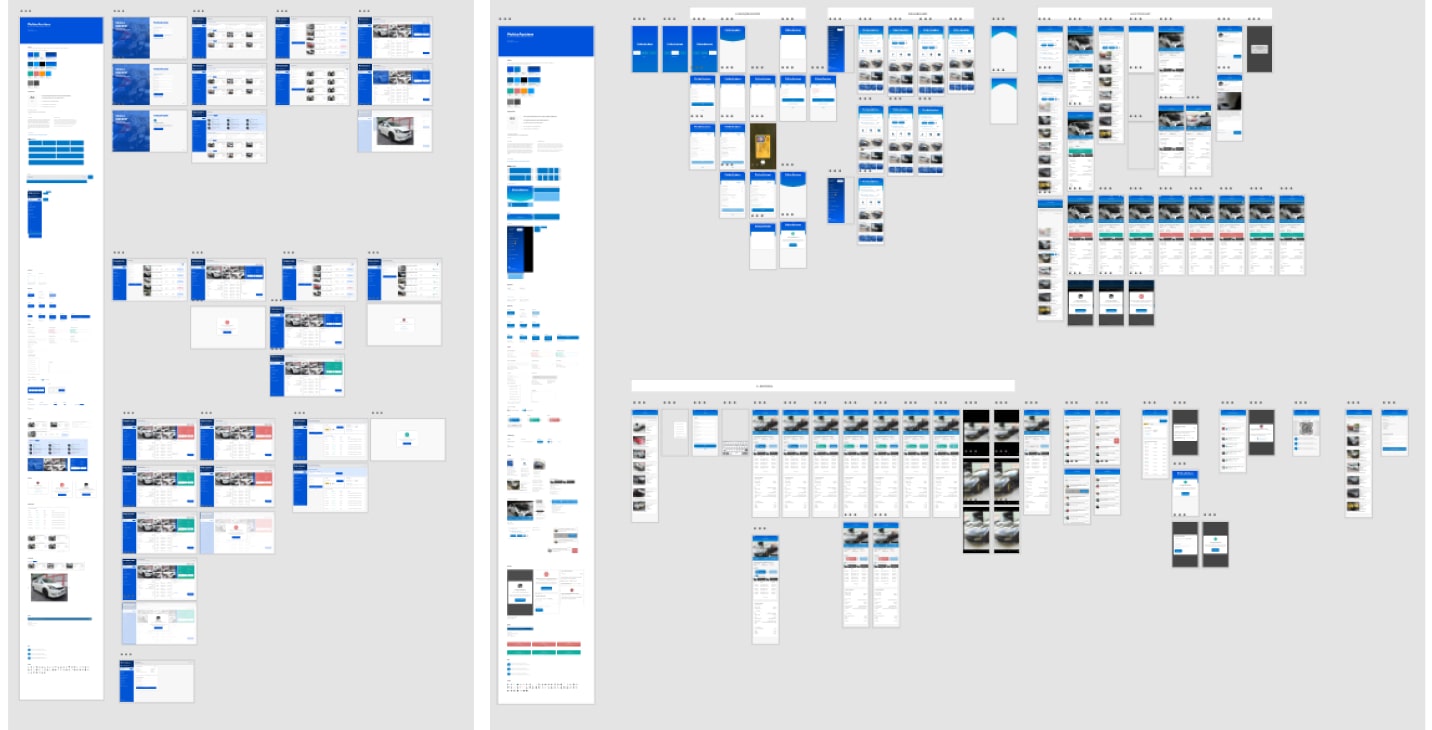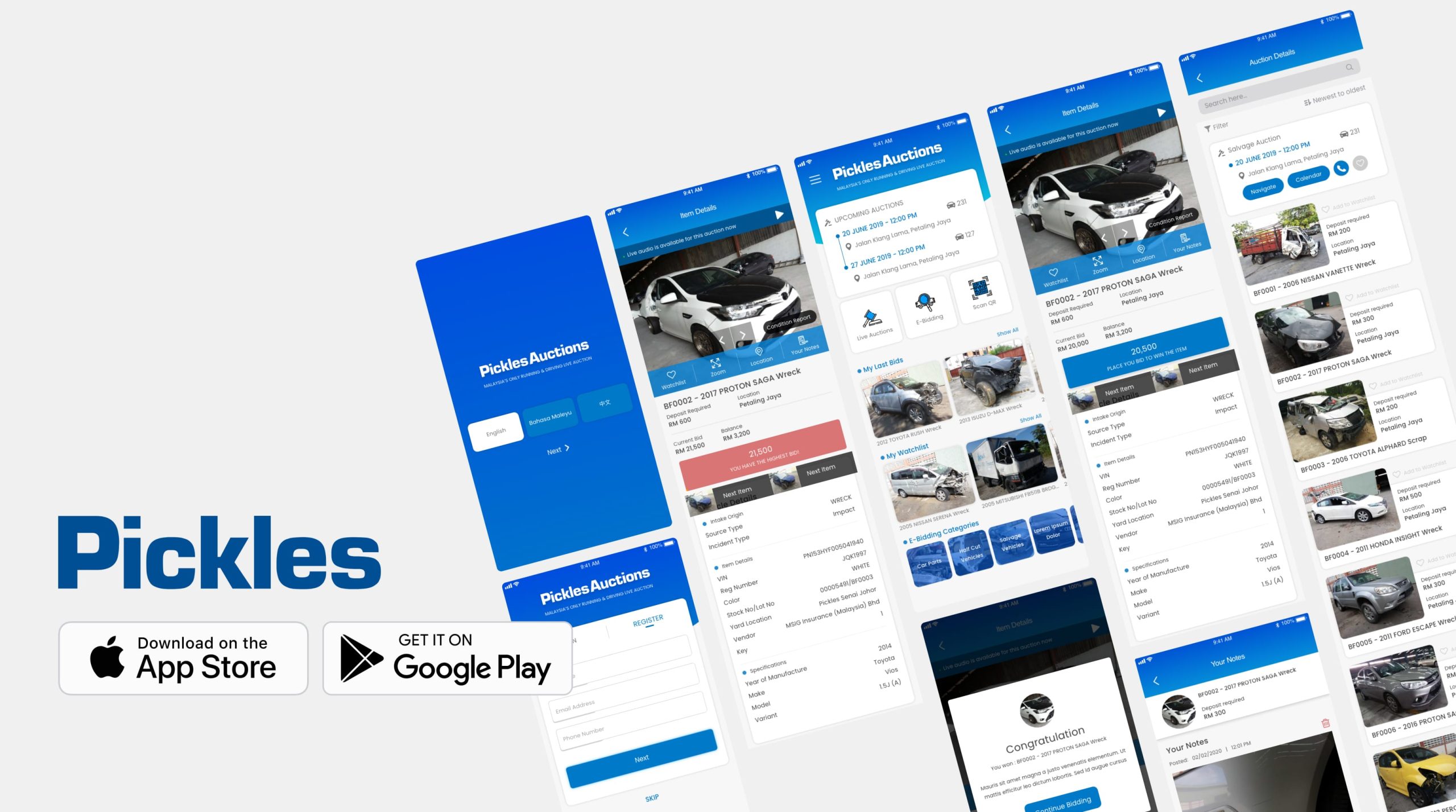Digitalized Car Auctions
Enhancing Engagement, Trust, and Accessibility: The Journey of Designing a Seamless Digital Auction Platform for Pickles Auction
Overview
The Pickles Auction application embarked on a groundbreaking project to digitalize the traditional in-house auction process, transforming it into a seamless online experience. The initiative took on even greater significance during the COVID-19 pandemic when businesses sought innovative ways to reduce physical attendance and ensure the safety of participants. By leveraging technology and user-centered design principles, the Pickles Auction application aimed to provide a platform that replicated the excitement and engagement of traditional auctions while offering the convenience and accessibility of an online environment.


As a UI/UX Designer on the Pickles Auction project, your role was instrumental in bringing the digital transformation to life. You played a crucial part in understanding the unique challenges and requirements of both the auction industry and the target users within the Malaysian market. Through extensive research, user interviews, and analysis, you gained insights into the dynamics of traditional auctions, the needs of potential bidders, and the concerns surrounding physical attendance during the pandemic.
Armed with this knowledge, you embarked on designing an intuitive user interface that would seamlessly bridge the gap between the traditional auction experience and the digital realm. Your design decisions were driven by the goal of ensuring a smooth and engaging user experience while maintaining the authenticity and excitement associated with auctions.
Collaborating closely with the development team, you translated your designs into functional prototypes that underwent rigorous testing and iterations. Usability testing played a crucial role in validating the effectiveness of the application, ensuring that it met the specific needs of both Buyers and Specific Buyers within the Malaysian market.

Challenge
The UI/UX project for Pickles Auction encountered several challenges. One of the main challenges was transitioning from traditional, in-person auction processes to a digital platform. This involved adapting legacy auction practices and streamlining complex bidding procedures for an online environment. Another challenge was establishing user engagement and trust in the virtual space, as the application needed to replicate the excitement and atmosphere of physical auctions while ensuring the security and authenticity of transactions.
- Legacy Auction Processes: The traditional auction industry relied heavily on in-person attendance, physical catalogs, and manual bidding processes. Transitioning these legacy processes into a digital platform posed several challenges, including adapting to a new online auction environment, streamlining complex bidding procedures, and maintaining trust and transparency in a virtual setting.
- User Engagement and Trust: Building user engagement and establishing trust were critical challenges. Online auctions required creating an immersive experience that replicated the excitement and atmosphere of physical auctions. Additionally, ensuring the security of transactions, providing accurate item descriptions, and addressing user concerns about authenticity were key aspects that required careful attention.
Solution
To address these challenges, the project embraced a user-centric design approach. Extensive user research was conducted to understand the needs, pain points, and expectations of buyers and sellers. This research informed the intuitive user interface design, focusing on easy navigation, transparent bidding processes, and comprehensive item descriptions. Building trust and transparency were prioritized through features such as secure payment gateways, detailed condition reports, and buyer/seller verification processes.
- User-Centric Design Approach: Adopting a user-centric design approach, extensive user research was conducted to understand the needs, expectations, and pain points of both buyers and sellers. This research informed the design decisions, ensuring that the application catered to user preferences, delivered a seamless experience, and addressed challenges specific to the auction industry.
- Intuitive User Interface: The design team focused on creating an intuitive user interface that enabled easy navigation, clear item descriptions, and transparent bidding processes. Visual cues, intuitive icons, and logical flow were incorporated to guide users through the auction journey and enhance engagement.
- Enhanced Trust and Transparency: To build trust, the design emphasized transparency in the auction process. This included providing comprehensive item details, condition reports, and historical data. Additionally, secure payment gateways and buyer/seller verification processes were implemented to enhance trust and ensure safe transactions.
Persona:
The Pickles Auction application caters to two distinct user types: the Buyer and the Specific Buyer. The Buyer attends auctions with the primary goal of finding a good deal on a variety of items. They are motivated by the opportunity to purchase items at discounted prices and seek value for their money. While they may have specific interests or categories in mind, they are open to exploring various options that align with their budget.
On the other hand, the Specific Buyer approaches auctions with a strategic mindset. They possess market knowledge and experience and are motivated by the potential for profit or finding specific items they actively seek. These users conduct thorough research, analyzing auction listings to identify items that have the potential for high resale value or fulfill their specific requirements. They prioritize expertise and market knowledge to make informed bidding decisions.
Understanding the distinct motivations and approaches of these user types is crucial in designing an effective auction application. By tailoring the features and user experience to cater to the needs of both Buyers and Specific Buyers, the Pickles Auction application can provide a seamless and engaging auction experience that meets the unique requirements of each user type.

Understanding user needs:
Based on our user types and targeted ones, I started to research their behaviors, expectations, and habits on the Auction day, which it finalized with a user journey to focus on.
Here are the process of my work:
Persona-based Questionnaire: To better understand the behavior, expectations, and habits of the Buyer and Specific Buyer user types, a comprehensive questionnaire was designed and administered to gather valuable insights. The questionnaire covered topics such as preferences for vehicle types, budget considerations, desired features, and past auction experiences. The responses from the questionnaire provided a solid foundation for understanding user behavior and tailoring the user journey accordingly.
Persona-Driven Research: Leveraging the data collected from the questionnaire, additional research was conducted to gain a deeper understanding of the users’ expectations, motivations, and pain points when participating in salvage car auctions. This research involved analyzing market trends, studying competitor offerings, and conducting interviews with industry experts to identify opportunities for improvement.
User Journey Mapping: Based on the insights gathered from the questionnaire and research, a user journey map was created to visualize the end-to-end experience of the Buyer and Specific Buyer user types. This user journey map outlined the various touchpoints, actions, and emotions that users would encounter when exploring and bidding on salvage cars through the Pickles Auction application. The map highlighted key stages such as search and discovery, item selection, bidding process, and post-auction activities.
Iterative Design and Testing: With the user journey map as a guide, iterative design and testing were conducted to ensure the user interface and features of the application aligned with the needs and expectations of the users. Wireframes, prototypes, and interactive mock-ups were created to validate design decisions and gather feedback from users. Usability testing sessions provided insights into the usability, intuitiveness, and effectiveness of the application, allowing for continuous improvement.

The primary user journey focused on enabling users to explore and bid on salvage cars with ease through the Pickles Auction application. By understanding the behavior, exceptions, and habits of the Buyer and Specific Buyer user types, the application was designed to address their unique needs and preferences. The result of this user-centric approach was a seamless and intuitive user journey that guided users through each stage of the auction process, from searching and discovering salvage cars to placing bids and completing transactions.
Users were provided with a visually appealing and user-friendly interface that allowed for effortless navigation, detailed vehicle information, and transparent bidding processes. The application incorporated features such as personalised recommendations, saved searches, real-time bidding updates, and secure payment options to enhance the overall user experience. This user journey resulted in increased engagement, improved user satisfaction, and excellent success rates in finding and acquiring desired salvage cars.
Through the implementation of the primary user journey, the Pickles Auction application successfully met the expectations and needs of its users, empowering them to participate in salvage car auctions with confidence, convenience, and efficiency. The result was a digital auction platform that provided a seamless and rewarding experience for buyers, while enabling sellers to reach a broader audience and maximise their auction outcomes.
Result
The UI/UX project for Pickles Auction yielded significant results. Users experienced an improved auction experience with a user-friendly interface, leading to increased engagement and higher user satisfaction levels. The digital platform expanded the reach of the auctions, attracting participants from various locations and creating a more competitive bidding environment. The project also brought about enhanced efficiency and scalability, eliminating manual tasks and reducing administrative burden. Ultimately, the digital platform resulted in positive business impacts, attracting new customers, facilitating successful transactions, and contributing to business growth and revenue generation.
- Through addressing the challenges, implementing user-centric solutions, and achieving positive results, the UI/UX project for Pickles Auction successfully transformed the traditional auction industry into a seamless, engaging, and trustworthy digital platform.
- Improved User Experience: The user-centered design approach, combined with an intuitive interface, resulted in an improved user experience. Users found it easier to explore auction listings, place bids, and manage their transactions. The seamless user experience led to increased engagement and higher user satisfaction levels.
- Increased Participation and Reach: The digital platform expanded the reach of the Pickles Auction beyond geographical limitations, enabling participants from different locations to join auctions. This increased participation, leading to a more competitive bidding environment and better outcomes for both buyers and sellers.
- Enhanced Efficiency and Scalability: The digitalization of auction processes resulted in improved efficiency and scalability. Manual tasks, such as catalog printing and physical registration, were eliminated, reducing administrative burden and costs. The digital platform also allowed for easier scalability, accommodating a larger volume of auctions and participants.
- Positive Business Impact: The user-friendly interface, improved user experience, and expanded reach translated into a positive business impact for Pickles Auction. The digital platform attracted new customers, increased buyer-seller interactions, and facilitated more successful transactions. Ultimately, the UI/UX project contributed to driving business growth, revenue generation, and market leadership in the online auction space.
Wireframe Creation:
After gaining insights from the user journey and understanding the needs and expectations of the users, you proceeded to create wireframes as a visual representation of the application’s layout, structure, and functionality. The wireframes focused on providing a clear and intuitive interface for users to navigate through the various stages of the auction process. Key elements, such as search filters, item details, bidding controls, and transactional flows, were carefully considered and incorporated into the wireframes.
To validate the effectiveness of the wireframes, an interactive version was developed and tested internally with the project team. This testing phase allowed for hands-on exploration of the application’s features and functionalities, uncovering any usability issues or areas for improvement. Additionally, a selected group of customers were invited to participate in the testing process during an actual auction day, providing real-time feedback and insights on the wireframe’s performance and usability.

During the testing phase, the wireframes received positive feedback overall, indicating that the design was on the right track. Users found the interface intuitive and easy to navigate, enabling them to explore auction listings, place bids, and complete transactions with relative ease. The interactive wireframes successfully captured the essence of the auction experience and provided users with a realistic representation of how the final application would function.
However, through the testing rounds, some areas for improvement and fine-tuning were identified. Feedback from the internal team and customers highlighted the need for clearer messaging, enhanced filtering options, and improved visual cues for bidding and item status updates. These valuable insights from the testing phase prompted two rounds of wireframe editing to address the identified issues and refine the user experience further.
By incorporating the feedback from testing and iteratively editing the wireframes, the design team was able to fine-tune the interface, improve usability, and enhance the overall user experience. The result of this iterative process was a set of wireframes that better aligned with user expectations, minimizing friction points, and increasing user satisfaction.
The successful testing of the interactive wireframes reinforced the confidence to proceed with the design process, knowing that the solutions offered met the needs and expectations of the users. The edited wireframes served as a solid foundation for further development, ensuring that the final design would be user-centered, intuitive, and capable of delivering a seamless and engaging auction experience to users.
High-fidelity UI Design (prototypes): The UI design phase of the Pickles Auction project involved translating the wireframes and conceptual ideas into visually appealing and functional user interfaces. The UI design aimed to create an intuitive and engaging experience for users, incorporating the branding elements of Pickles Auction while ensuring ease of use and accessibility. Attention was given to typography, color schemes, layout, and visual hierarchy to create a cohesive and visually appealing interface that aligned with the user preferences and expectations identified during the research phase. Iterative design processes and feedback loops were followed to refine the UI designs and ensure they effectively communicated the functionalities and features of the application.

Implementation:
Upon completion of the UI design phase, the finalized UI designs were delivered to the development team for implementation. This involved providing the development team with comprehensive design specifications, style guides, and assets necessary for accurately translating the UI designs into a fully functional application. Collaboration between the UI/UX designers and the development team ensured a smooth handoff and clear communication of design intent. Regular meetings and checkpoints were scheduled to address any questions, provide clarifications, and ensure that the UI designs were implemented faithfully. The delivery phase encompassed close collaboration between the design and development teams to ensure a seamless transition from design to development and facilitate the creation of a high-quality user interface for the Pickles Auction application.
